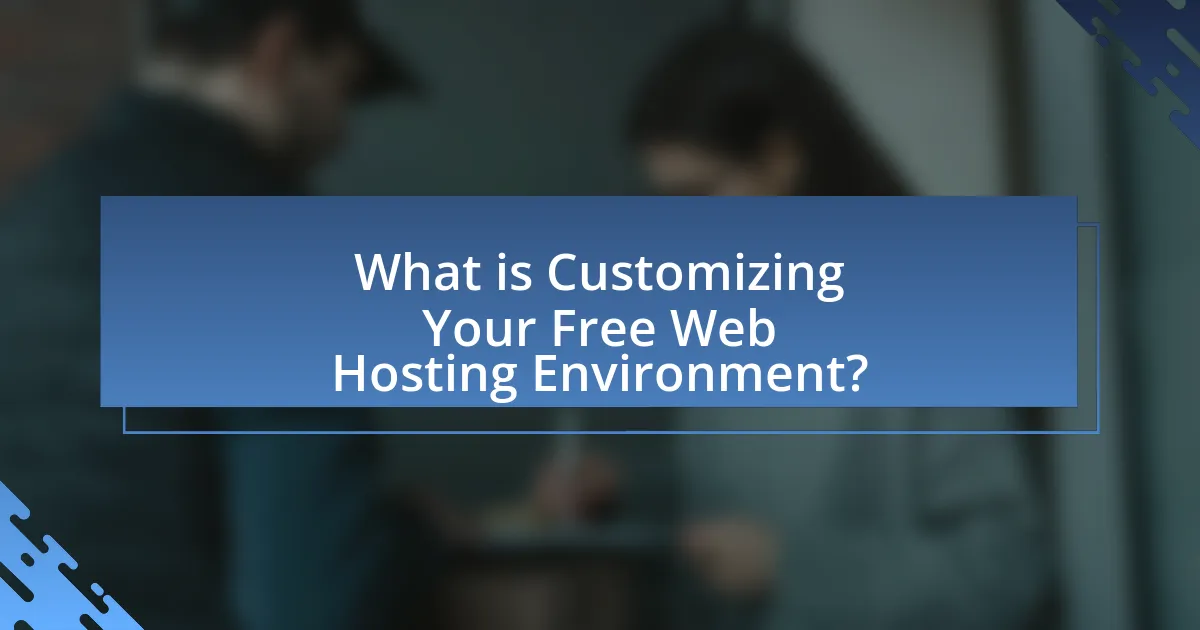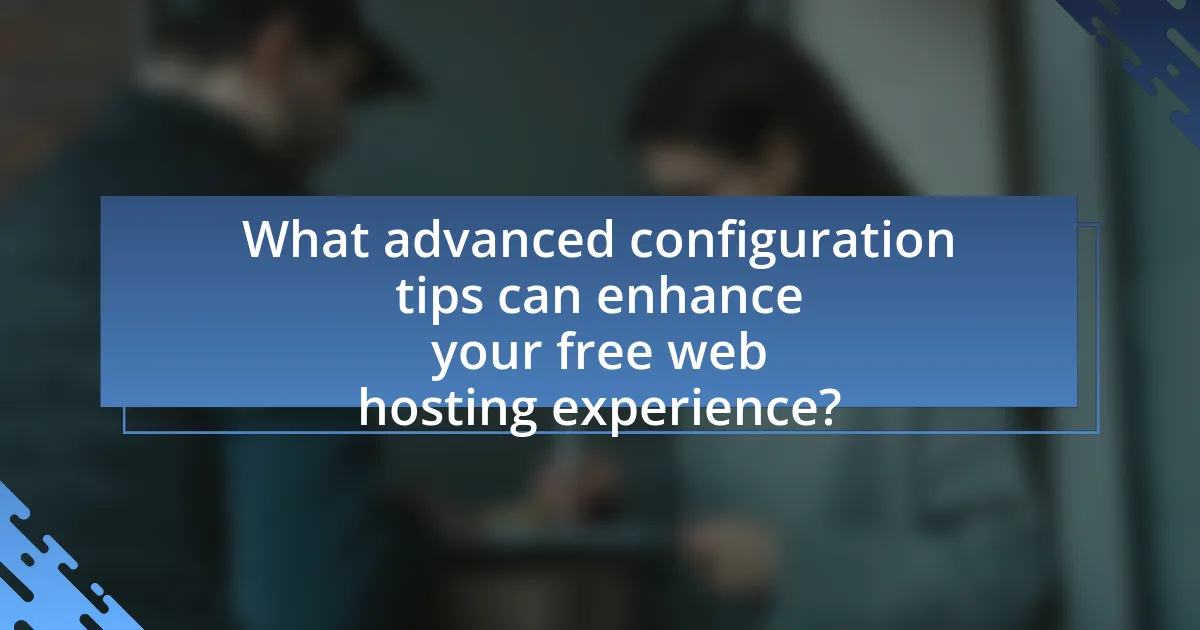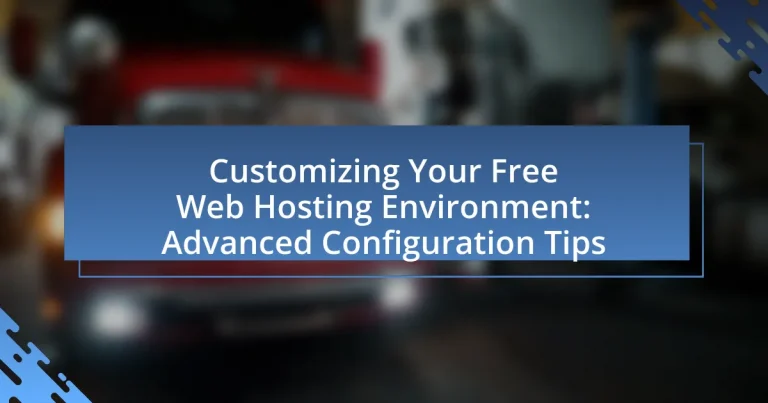Customizing your free web hosting environment involves modifying settings and configurations to enhance website functionality and user experience. This article explores the definition of free web hosting, its key features, and the differences between free and paid options. It emphasizes the importance of customization for improving performance and user engagement while addressing common challenges and limitations faced by users. Additionally, the article provides advanced configuration tips, optimization strategies for speed and security, and best practices for maintaining a customized hosting environment, ensuring users can effectively tailor their websites to meet specific needs.

What is Customizing Your Free Web Hosting Environment?
Customizing your free web hosting environment involves modifying settings and configurations to better suit your specific needs and preferences. This process can include adjusting server settings, selecting software applications, and optimizing performance features to enhance the functionality and user experience of your website. For instance, many free web hosting services allow users to change PHP settings, manage databases, and install content management systems, which can significantly improve site performance and usability.
How can you define a free web hosting environment?
A free web hosting environment is a service that allows individuals or organizations to host their websites without incurring any costs. This type of hosting typically provides limited resources, such as storage space and bandwidth, and may include advertisements or restrictions on features compared to paid hosting services. According to a 2021 survey by HostingAdvice, approximately 30% of website owners initially use free hosting options before transitioning to paid services, highlighting the prevalence and utility of free web hosting environments for beginners and small projects.
What are the key features of free web hosting services?
Free web hosting services typically offer features such as limited storage space, bandwidth restrictions, and basic website builders. These services often include subdomain usage instead of a custom domain, which can affect branding. Additionally, free hosting may come with advertisements displayed on the hosted site, limiting user experience. Security features are usually minimal, and customer support is often limited or non-existent. According to a 2021 survey by HostingAdvice, 70% of users reported dissatisfaction with the performance and reliability of free hosting services, highlighting the trade-offs involved.
How does free web hosting differ from paid options?
Free web hosting differs from paid options primarily in terms of features, reliability, and support. Free web hosting typically offers limited storage, bandwidth, and lacks advanced features such as custom domain names, SSL certificates, and technical support. In contrast, paid hosting services provide greater resources, enhanced security, and customer support, which are essential for businesses and professional websites. For example, a study by HostingAdvice in 2021 indicated that 70% of users experienced downtime with free hosting compared to only 5% with paid services, highlighting the reliability gap.
Why is customization important in a free web hosting environment?
Customization is important in a free web hosting environment because it allows users to tailor their websites to meet specific needs and preferences. This flexibility enhances user experience, improves functionality, and can lead to better engagement with visitors. For instance, users can modify themes, plugins, and settings to align with their brand identity, which is crucial for establishing a professional online presence. Additionally, customization can optimize website performance by enabling users to implement features that cater to their audience, such as faster loading times or specific content layouts.
What advantages does customization provide for users?
Customization provides users with enhanced control over their web hosting environment, allowing them to tailor settings and features to meet specific needs. This personalization leads to improved user experience, as users can optimize performance, security, and functionality according to their unique requirements. For instance, a study by the Nielsen Norman Group found that user satisfaction increases by 20% when individuals can customize their interfaces. This demonstrates that customization not only empowers users but also significantly enhances their overall engagement and effectiveness in utilizing web hosting services.
How can customization enhance website performance?
Customization can enhance website performance by allowing tailored configurations that optimize resource usage and improve user experience. By adjusting settings such as caching mechanisms, image compression, and database queries, websites can load faster and handle higher traffic volumes efficiently. For instance, a study by Google found that a one-second delay in page load time can lead to a 20% decrease in conversion rates, highlighting the importance of performance optimization through customization. Additionally, personalized content delivery based on user preferences can reduce server load and enhance engagement, further contributing to improved performance metrics.
What are the common challenges faced when customizing free web hosting?
Common challenges faced when customizing free web hosting include limited resources, lack of technical support, and restrictions on features. Limited resources often result in insufficient bandwidth and storage, hindering the ability to implement complex customizations. The absence of technical support can leave users struggling to resolve issues independently, which can be particularly challenging for those without advanced technical skills. Additionally, many free hosting services impose restrictions on features such as database access, scripting capabilities, and the installation of third-party applications, which can significantly limit customization options. These factors collectively create obstacles for users aiming to tailor their web hosting environment effectively.
What limitations do free hosting services impose on customization?
Free hosting services impose significant limitations on customization, primarily restricting users from modifying server settings, installing custom software, and accessing advanced features. These services often provide a limited set of templates and themes, which can hinder the ability to create a unique website design. Additionally, users may face restrictions on the use of certain programming languages or databases, further limiting functionality. For instance, many free hosting platforms do not allow the use of PHP or MySQL, which are essential for dynamic website development. These constraints are designed to maintain server stability and performance but ultimately restrict the level of personalization and control users have over their web hosting environment.
How can users overcome these challenges effectively?
Users can effectively overcome challenges in customizing their free web hosting environment by utilizing comprehensive guides and community forums for troubleshooting. These resources provide step-by-step instructions and solutions to common issues, enabling users to implement advanced configurations successfully. For instance, platforms like Stack Overflow and specific web hosting community forums offer a wealth of shared experiences and expert advice, which can significantly reduce the learning curve associated with complex setups. Additionally, leveraging online tutorials and documentation from hosting providers can clarify specific configuration processes, ensuring users can navigate challenges with confidence.

What advanced configuration tips can enhance your free web hosting experience?
To enhance your free web hosting experience, consider optimizing your server settings, utilizing a content delivery network (CDN), and implementing caching mechanisms. Optimizing server settings, such as adjusting PHP memory limits and execution times, can significantly improve performance. Using a CDN can reduce latency and increase loading speeds by distributing content across multiple servers globally. Implementing caching mechanisms, like browser caching and server-side caching, minimizes server load and speeds up content delivery. These strategies are supported by studies showing that optimized configurations can lead to faster load times and improved user experience, which are critical for retaining visitors and enhancing site performance.
How can you optimize your website’s speed on a free hosting platform?
To optimize your website’s speed on a free hosting platform, you should minimize file sizes and leverage caching techniques. Reducing image sizes through compression tools like TinyPNG can decrease load times significantly, as images often account for a large portion of page weight. Additionally, implementing browser caching allows returning visitors to load your site faster by storing static resources locally, which can improve speed by up to 80% according to Google’s PageSpeed Insights. Furthermore, using a Content Delivery Network (CDN) can distribute your content across multiple servers, reducing latency and improving load times for users in different geographical locations.
What caching techniques can be applied?
Various caching techniques can be applied to enhance web hosting performance, including file caching, opcode caching, and object caching. File caching stores static files on the server to reduce load times, while opcode caching compiles PHP scripts into bytecode, improving execution speed. Object caching stores database query results in memory, minimizing database load and speeding up data retrieval. These techniques collectively optimize resource usage and improve user experience by decreasing latency and increasing response times.
How does image optimization contribute to speed improvements?
Image optimization significantly contributes to speed improvements by reducing the file size of images without compromising quality. Smaller image files load faster, which decreases the overall page load time, enhancing user experience and potentially improving search engine rankings. For instance, studies show that optimized images can reduce load times by up to 80%, leading to lower bounce rates and higher engagement. This is particularly crucial for websites, as faster loading times correlate with increased user satisfaction and retention.
What security measures should you implement in a free web hosting environment?
To enhance security in a free web hosting environment, implement measures such as using strong, unique passwords, enabling two-factor authentication, and regularly updating software. Strong passwords reduce the risk of unauthorized access, while two-factor authentication adds an extra layer of security by requiring a second form of verification. Regular software updates patch vulnerabilities that could be exploited by attackers. According to a 2021 report by Verizon, 81% of data breaches are linked to weak or stolen passwords, highlighting the importance of these security practices.
How can you secure your website against common threats?
To secure your website against common threats, implement HTTPS, utilize strong passwords, and regularly update software. HTTPS encrypts data between the user and the server, significantly reducing the risk of data interception. Strong passwords prevent unauthorized access; using a combination of letters, numbers, and symbols enhances security. Regular software updates patch vulnerabilities, as evidenced by the fact that 60% of breaches exploit known vulnerabilities that could have been mitigated through timely updates. Additionally, employing firewalls and security plugins can further protect against attacks such as SQL injection and cross-site scripting.
What role do SSL certificates play in website security?
SSL certificates play a crucial role in website security by encrypting data transmitted between a user’s browser and the web server. This encryption protects sensitive information, such as login credentials and payment details, from being intercepted by malicious actors. According to a study by Google, websites using HTTPS (enabled by SSL certificates) are significantly less likely to be compromised compared to those using HTTP. Furthermore, SSL certificates also authenticate the identity of the website, ensuring users are communicating with the legitimate site and not an imposter, which enhances trust and security.
How can you customize your website’s appearance and functionality?
You can customize your website’s appearance and functionality by utilizing CSS for styling and JavaScript for interactive features. CSS allows you to change colors, fonts, layouts, and overall design elements, while JavaScript enables dynamic content updates, form validations, and user interactions. For instance, using CSS frameworks like Bootstrap can streamline the design process, providing pre-built components that enhance visual appeal. Additionally, integrating JavaScript libraries such as jQuery can simplify DOM manipulation and event handling, improving user experience. These methods are widely adopted in web development, as evidenced by the prevalence of CSS and JavaScript in over 90% of websites, according to W3Techs statistics.
What themes and templates are available for free hosting users?
Free hosting users typically have access to a limited selection of themes and templates designed for basic website functionality. Commonly available options include simple, responsive designs that cater to various niches such as blogs, portfolios, and small business sites. These themes often feature customizable layouts, basic color schemes, and essential widgets. For example, platforms like WordPress and Wix provide free themes that are optimized for mobile devices and include drag-and-drop functionality, making it easier for users to create and manage their websites without advanced technical skills.
How can plugins enhance the functionality of your website?
Plugins can enhance the functionality of your website by adding specific features and capabilities that are not included in the core platform. For instance, plugins can enable e-commerce functionality, improve SEO, enhance security, and integrate social media sharing, thereby allowing website owners to tailor their sites to meet specific needs. According to a study by W3Techs, over 60% of websites use plugins to extend their capabilities, demonstrating their widespread adoption and effectiveness in improving user experience and site performance.

What are the best practices for maintaining a customized free web hosting environment?
The best practices for maintaining a customized free web hosting environment include regular backups, monitoring performance, optimizing resource usage, and ensuring security. Regular backups protect data from loss, while monitoring performance helps identify issues before they escalate. Optimizing resource usage, such as managing bandwidth and storage, ensures the hosting environment runs efficiently. Security measures, including using strong passwords and keeping software updated, protect against vulnerabilities. These practices are essential for sustaining a reliable and effective web hosting experience.
How can regular updates improve your web hosting experience?
Regular updates can significantly enhance your web hosting experience by ensuring improved security, performance, and compatibility. Security vulnerabilities are often addressed in updates, reducing the risk of cyberattacks; for instance, a study by the Ponemon Institute found that 60% of data breaches are linked to unpatched vulnerabilities. Additionally, updates can optimize server performance, leading to faster load times and better resource management, which is crucial for user satisfaction and SEO rankings. Compatibility with the latest software and technologies is also maintained through updates, ensuring that your hosting environment remains efficient and functional.
What should you prioritize when updating your website?
When updating your website, you should prioritize user experience and performance optimization. Enhancing user experience involves ensuring that the website is easy to navigate, visually appealing, and mobile-friendly, as studies show that 88% of online consumers are less likely to return to a site after a bad experience. Performance optimization includes improving loading times and reducing server response times, which can significantly impact search engine rankings; for instance, Google has indicated that page speed is a ranking factor. Therefore, focusing on these aspects will lead to better engagement and higher visibility in search results.
How often should you perform maintenance checks?
Maintenance checks should be performed at least once a month. Regular monthly checks help identify potential issues early, ensuring optimal performance and security of the web hosting environment. According to industry best practices, monthly maintenance can reduce downtime by up to 30% and enhance overall system reliability.
What troubleshooting tips can help resolve common issues in free web hosting?
To resolve common issues in free web hosting, users should first check server status and uptime, as many free hosting services experience downtime. Next, users should verify their domain settings to ensure proper DNS configuration, which can often lead to accessibility issues. Additionally, clearing browser cache can resolve loading problems, as outdated files may cause display errors. Users should also review error logs provided by the hosting service to identify specific issues, as these logs can offer insights into server errors or misconfigurations. Finally, reaching out to customer support can provide tailored assistance, as many free hosting providers offer limited support but can help troubleshoot specific problems.
How can you identify and fix performance issues?
To identify and fix performance issues, conduct a thorough analysis of server metrics, application logs, and user feedback. Monitoring tools such as New Relic or Google Analytics can provide insights into load times, error rates, and resource usage, allowing for pinpointing specific bottlenecks. For instance, if server response times are high, optimizing database queries or increasing server resources may be necessary. Additionally, implementing caching strategies can significantly enhance performance by reducing load on the server. Regularly reviewing these metrics and making adjustments based on the data ensures ongoing optimization and improved user experience.
What steps should you take if your website goes down?
If your website goes down, first check the server status to determine if the issue is on your end or the hosting provider’s end. Next, review error messages or logs to identify specific problems, such as server overload or coding errors. After diagnosing the issue, restart the server or clear the cache to resolve temporary glitches. If the problem persists, contact your hosting provider for assistance, as they may have insights or solutions for server-related issues. According to a 2021 study by the Uptime Institute, 70% of downtime incidents are due to human error or misconfiguration, highlighting the importance of proper server management and monitoring.
What practical tips can enhance your customization efforts?
To enhance your customization efforts in a free web hosting environment, focus on utilizing available tools and features effectively. Start by exploring the control panel provided by your hosting service, as it often includes options for modifying settings, installing applications, and managing databases. For instance, using a content management system like WordPress can significantly streamline the customization process, allowing for easy theme and plugin integration. Additionally, leveraging CSS and HTML for styling can provide a more tailored appearance to your site. Research indicates that websites with customized designs can improve user engagement by up to 80%, highlighting the importance of personalization in web hosting.
How can you leverage community resources for support?
You can leverage community resources for support by actively engaging with online forums, local meetups, and social media groups focused on web hosting and technology. These platforms provide access to a wealth of knowledge, allowing you to ask questions, share experiences, and receive guidance from experienced users and professionals. For instance, platforms like Stack Overflow and Reddit have dedicated communities where users discuss specific issues related to web hosting configurations, offering practical solutions and advice based on real-world experiences. Engaging with these resources can significantly enhance your understanding and troubleshooting capabilities in customizing your free web hosting environment.
What tools can assist in the customization process?
Tools that can assist in the customization process include website builders, content management systems (CMS), and code editors. Website builders like Wix and Squarespace provide user-friendly interfaces for customization without coding knowledge. Content management systems such as WordPress and Joomla offer extensive themes and plugins that allow for deeper customization options. Code editors like Visual Studio Code and Sublime Text enable developers to modify code directly for tailored configurations. These tools are widely used in the industry, with WordPress powering over 40% of all websites, demonstrating their effectiveness in facilitating customization.


